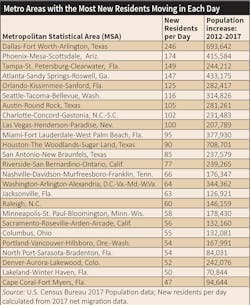Are you starting to look ahead and think about how business will be in 2019? You don’t have to be a Harvard economist to figure out where your local market may be headed next year. A great resource may be just a phone call away.
This is the time of year when electrical distributors put together strategic business plans for the next 12 months. Part of that process is forecasting their company sales for next year and figuring out which market areas or customers will provide the most growth. You may be thinking about the same thing for your electrical contracting business.
So here’s a crazy idea. If one of your favorite distributors is going through this process right now, why not ask them if they would be interested in creating a joint business plan to go after some of the same customers or markets? Let’s face it — you’re both interested in having a business relationship and building sales with many of the same end-users, whether it be building owners, home builders, the industrial maintenance departments of local factories, or other end-users. Sometimes you have the contacts with these customers, and other times it may be the distributor who knows them best. Why not work with a select distributor or two to develop a joint business plan to mutually grow revenues next year, where your companies target specific growth areas or specific customers in your local market area? It’s a win-win for both of you.
Market Data That Matters
Part of developing a joint business plan should include an analysis of the health of the construction market in your area. There’s free information out there that can help you do this. Four key (and free) economic indicators that will give you a decent sense of what the construction market will look like in your backyard next year are building permits, population growth, employment trends, and construction projects. Let’s look at each of them now.
Building permits. Even if you don’t focus on new home construction or on service work for the residential market, building permits are an important indicator to track. They are what economists call an “early indicator” of future economic activity. Once a new housing project breaks ground, it often isn’t too much longer before new businesses start up nearby to service the needs of the new homeowners. Those new homeowners need to buy everything from furniture for that home to landscaping for the yard, and all the other shopping they do in area businesses contributes to the health of the local economy.
The two best sources for local, state, and regional building permit data are the National Association of Home Builders (NAHB) and the U.S. Census Bureau.
Population growth. When you dig into the free population data available from the U.S. Census Bureau, you quickly learn that some areas of the country are growing at an amazing rate, while others are losing population year after year. The fastest-growing metropolitan areas tend to be in what’s called the Sunbelt, in states like North and South Carolina, Florida, Texas, Arizona, and California, mountain states like Colorado and Utah, and cities like Las Vegas, Seattle, and other market areas that attract new residents because of a vibrant economy, attractive lifestyle for young folks or retirees, or a desirable climate.
Single-family permits per thousand residents. Growth in building permits and growth in population are related, and you can look at the ratio of single-family building permits and permits per 1,000 residents to size up how fast market areas of different sizes are growing. The U.S average is 1.6 building permits per 1,000 residents. Some markets are pulling permits at triple that pace or more. Developing this ratio for your market area is simple. Get the population number from the U.S. Census Bureau, and divide it by a thousand. Then get your single-family building permits, and divide it by that number.
New residents per day. This ratio helps you look at which cities and metropolitan areas have the most people moving into the market (see the Table). In the government data, these metros are called either core-based statistical area (CBSA) or Metropolitan Statistical Areas or MSAs. Go to the Census Bureau website, and download the file under “Datasets” called “Combined Statistical Area Totals Dataset: Population and Estimated Components of Change: April 1, 2010, to July 1, 2017.” After you download this file, the population data you need is in Column BT, named “NETMIG2017” (Net migration 2017). Find the metropolitan area of interest and divide it by 365 (for the number of days in the year) to give you the average number of new residents moving into the area.
Employment trends. The U.S. Bureau of Labor Statistics (BLS) offers monthly updates of employment data for all sorts of different occupations and industries. There’s a mountain of data on this website, and it may take a little bit of wandering around on it to find what you need. But you can find data by job type at the county, MSA, state, regional, and national level that will be helpful in determining employment growth trends for your market area of interest.
Construction projects. You may already have a good feel for what jobs are underway or on the drawing boards in your local market area. But if you need additional sources of information, check out the free AGC SmartBrief newsletter published by Associated General Contractors (AGC). It aggregates stories on construction projects from all over the country. The regional Business Journals published in 43 metro areas by American City Business Journals are also a great source of information if your market area is covered. The local websites for these publications have article limits, so get a subscription to your local Business Journal if you need it on a regular basis.
If you need a ton of project data, the two largest providers of construction project data are Dodge Data & Analytics and ConstructConnect. You have to purchase this data, but it may be worth checking out if large construction projects are of interest.
By watching these economic indicators, you may not need to invest in that MBA in economics to measure potential growth in your market. With a little work — and possibly the help of a local distributor — you may be able to do it all by yourself.
About the Author
Jim Lucy
Editor-in-Chief, Electrical Wholesaling & Electrical Marketing
Over the past 40-plus years, hundreds of Jim’s articles have been published in Electrical Wholesaling, Electrical Marketing newsletter and Electrical Construction & Maintenance magazine on topics such as electric vehicles, solar and wind development, energy-efficient lighting and local market economics. In addition to his published work, Jim regularly gives presentations on these topics to C-suite executives, industry groups and investment analysts.
He launched a new subscription-based data product for Electrical Marketing that offers electrical sales potential estimates and related market data for more than 300 metropolitan areas. In 1999, he published his first book, “The Electrical Marketer’s Survival Guide” for electrical industry executives looking for an overview of key market trends.
While managing Electrical Wholesaling’s editorial operations, Jim and the publication’s staff won several Jesse H. Neal awards for editorial excellence, the highest honor in the business press, and numerous national and regional awards from the American Society of Business Press Editors. He has a master’s degree in communications and a bachelor’s degree in journalism from Glassboro State College, Glassboro, N.J. (now Rowan University) and studied electrical design at New York University and graphic design at the School for Visual Arts.


